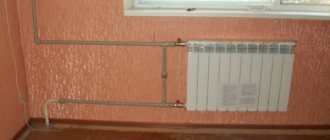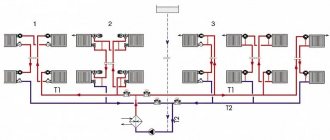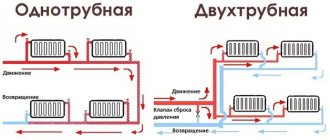Every citizen has a constitutional right to favorable living conditions, and the optimal temperature in the apartment is a component of comfort. Central heating ensures comfort in the house even in severe frosts. Housing and public utilities services, distribution centers or management companies are responsible for the quality of heating systems.
Cold radiators during the heating season are a direct violation of civil rights. To make a claim, you need to know exactly when the heating is turned on and understand some of the nuances of organizing heating of residential premises.
What law regulates the process of heating residential premises?
Relations in the field of heat supply to residential premises are regulated at the federal level by the following legislative acts:
- Federal Law “On Heat Supply” dated July 27, 2010 No. 190-FZ.
- Decree of the Government of the Russian Federation “On the provision of public services” No. 354 dated May 6, 2011.
- GOST 30494-2011 “Indoor microclimate parameters” dated 01/01/2013.
The above documents define the relationship between owners and utilities, the start and end dates of the heating season, as well as the rules for the provision and calculation of utilities.
System nuances
It is logical that in the summer there is no need for heating. Therefore, during the warm season the heating is turned off. This usually happens in the spring, after the temperature outside has established itself and remains at least +8 for 5 days. The heat supply is usually turned on in the fall.
Turning off heating for the summer allows citizens to save on utilities. At the same time, service organizations can check the serviceability of engineering systems, identify and eliminate faults, or replace worn out elements.
Principles of district heating
A centralized water heating system is the most popular option for supplying heat to apartment buildings. Heat energy is supplied from thermal power plants via heating networks and intra-house communication systems.
Monitoring the maintenance of an optimal microclimate helps to implement the heating temperature schedule. It is compiled based on the following indicators:
- temperature in the water supply and outlet pipes in the heating system and the difference between them;
- temperature outside and inside the room.
The colder the air outside the window, the higher the temperature of the water in the battery should be. A heating schedule is needed to adjust equipment power when weather conditions change.
With its help, several problems are solved at once:
- energy consumption is optimized;
- the optimal temperature level in the room is maintained;
- citizens' costs for paying utility bills during the heating season are reduced.
The heating schedule must be attached to the service contract with housing and communal services or RSO.
Beginning of the heating season in Russian regions
The heating season is the period of time in which heat is supplied through a centralized heating system. Previously, six months were allotted for heating activities - from October 15 to April 15.
However, due to differences in weather conditions in different regions, it was decided to determine the date for turning on the heating system based on a combination of the following factors:
- average daily temperature;
- weather forecast for the near future.
If within five days the average daily temperature does not exceed +8 °C, the district administration adopts a resolution on the opening date of the heating season. The timing may be adjusted if warming is predicted.
Time range for turning on central heating systems by region:
| Region | Start date of the heating season |
| Nenets Autonomous Okrug, Omsk, Arkhangelsk, Murmansk regions | Beginning of September |
| Saint Petersburg | Mid September, early October |
| Moscow and Moscow region, Central Black Earth Region | Early October |
| Southern regions* | Mid-October, end of November |
* In the city of Sochi, only 3 months are allotted for the heating season. In this region, heating is turned on in mid-November, and turned off at the end of February, beginning of March.
Heat is supplied to objects in the following order:
- kindergartens, schools, hospitals and other buildings of social significance;
- administrative and industrial buildings;
- residential premises.
Interesting! In houses with autonomous heat transfer systems, the start and end dates of heating activities are set by the decision of the owners.
Features of the end of the central heating season
The heat supply is stopped if the average daily temperature is more than +8 °C for five days. However, due to the instability of weather conditions, management companies prefer to play it safe and are in no hurry to turn off the central heating, because restarting the system is a very labor-intensive undertaking.
The start and end dates of the heating season are determined by municipal, not utility services. The municipality sends an order to the CHP, which, in turn, notifies the housing and communal services and management services about the timing of turning on and off the heat supply.
The resolution on the heat supply schedule is published on the website of the district administration. If the heating is not turned on on the specified dates, this can serve as a precedent for a complaint.
Rules for the provision of public services
This document was approved by government decree No. 354 of 2011. The Rules provide explanations on many issues related to the provision of housing and communal services to the population. They also explain the procedure for supplying heat.
As established in paragraph 5 of the Rules, if the supply of thermal energy for heating is carried out through in-house engineering systems of a centralized supply network, then the beginning and end of the heating period is established by the authorized body. Moreover, it must begin no later than and end no earlier than the day following the end date of the five-day period during which the average daily air temperature outside was below or above 8 degrees. respectively.
Step-by-step instructions for filing a complaint about late heating switching on
A complaint about the lack of heating can only be filed after official confirmation of the start date of the heating season. The application is drawn up in the name of the head of the organization with which the contract for heat supply services was concluded.
The form of the document is free, but it is necessary to indicate the following information:
- Full name and contact details of the applicant;
- description of the problem and a list of measures that were taken to solve it;
- list of requirements;
- date of application and signature of the apartment owner.
The complaint is drawn up in two copies. The first is transferred to the authorized person, and the second remains with the owner.
Important! The owner's copy must be marked with the date the claim was received. If any documents appeared during the settlement of the issue, certified copies of them must be attached to the complaint.
conclusions
Based on the information provided, we can conclude the following. The authority to make decisions on the start of the heating season is vested in local authorities. The exception is federal cities. values (St. Petersburg, Sevastopol, Moscow). In them, relevant decisions can be adopted by government bodies.
The heating period should begin after five days, during which the average daily temperature was at +8. Simply put, heat is supplied on the sixth day. At the same time, the law does not prohibit starting the heating period earlier than the specified time. But, in any case, there must be a decision by local authorities.
Is it possible to turn off during the heating season?
Accidents on heating mains are not uncommon. Such force majeure, as a rule, entails the shutdown of hot water supply and heating. The legislation provides for standards for one-time shutdown of heating, which must be observed.
Standards for turning off heating during the season:
| Room temperature in °C | Shutdown time in hours |
| +12 | 16 |
| +10 to +12 | 8 |
| +8 to +10 | 4 |
Important! If the apartment owner proves that the temperature in the room does not meet the approved standards, he may demand financial compensation in the amount of 0.15% of the monthly heating fee for each hour of violation.
How to heat an apartment in the off-season
It may take a long time before the average daily temperature reaches the conditional level at which the management company is obliged to turn on the heating. In autumn, the sun does not warm up the walls much, and with the onset of darkness they quickly cool down, sucking the heat out of the room. You can heat the apartment while waiting for the central heating to start using additional equipment:
- oil radiator;
- fan heater;
- air heating unit.
Double-glazed windows or inexpensive, but quite effective, sealing of windows for the winter will allow you to retain heat.
What to do if there is no heat in the apartment
After the onset of winter cold, the temperature of living quarters should not fall below +18 °C. If the heating system cannot provide the temperature regime specified by GOST, the owner must immediately notify the emergency dispatch service of the presence of violations. Applications can be accepted by telephone or in person. In both cases, the dispatcher is required to provide his details and record the time the complaint was received.
Upon request, an examination is carried out. If the owner of the apartment has not determined his time for carrying it out, then the inspection is carried out within two hours after receipt of the application.
Based on the results of the inspection, a report is drawn up containing the following information:
- measurement methodology;
- tools and devices used;
- identified violations or the absence of such violations;
- date and time of the inspection.
If the results of the inspection by the management company do not satisfy the owner, he has the right to request a re-examination with the participation of members of the State Property Committee and the public association of consumers.
How to determine the average daily temperature
The average daily temperature is defined as the arithmetic mean of all measurements taken over 24 hours. To calculate it, you need to do the following:
- take air temperature measurements at intervals of 4 hours (the interval can be any);
- add all values;
- divide the resulting amount by the number of measurements.
The result will be the average temperature for the day.
Where to complain if batteries stay cold
In the event of a lack of heat, apartment owners can file a complaint with one of the organizations responsible for maintaining the building:
- management company;
- housing and communal services service or RSO;
- housing inspection.
If contacting local authorities does not bring the desired result, it is necessary to file a formal complaint with higher authorities:
- local administration;
- Rospotrebnadzor;
- the prosecutor's office;
- court.
Official requests can be left on the websites of the above organizations.
Features of heat supply
Heating is supplied to houses according to certain rules. If the supply is carried out through central utility networks, then the heat is supplied through the pipeline. It is connected to the central boiler houses of the corresponding area and thermal power plants. From there he goes to houses.
In central boiler houses water is used as a coolant. The heating systems used allow you to keep its temperature at the same level. In thermal power plants, the coolant is steam. It first goes to turbines, where it is used to generate electricity, and then goes into the pipeline.
Direct supply of steam or water is carried out into an extensive engineering network. It runs above and below ground to the structures. The network has two pipes. According to the first, the coolant is supplied to consumers, and according to the second, it is already cooled and returned back. Due to continuous circulation, the optimal temperature is maintained in the apartments.
As a rule, pipes with a cross-section of up to 140 cm are used in engineering heating networks. They are made of steel sheets and protected by thermal insulation materials.
The apartments have thin pipes and radiators that increase heating efficiency.











